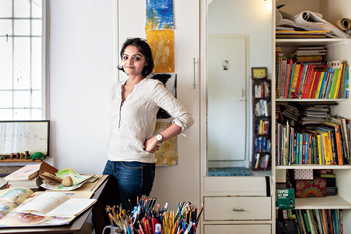Art allows for universalisation of feelings and experiences and therefore, needs to be protected and encouraged. In the context of children’s literature, before a child learns to read and understand, they learn to see. To observe and absorb all the colours, shapes, sizes, and movements around them. Visuals are the gateway to a child’s mind. And just like that, illustrations are a gateway to the imaginary world created by the child every time they read a book. While the text and narrative have an ever-important role to play in growth and development, illustrations can nurture imagination and creativity from an early age.
Over the years, authors and illustrators alike have worked together to create stories that are more inclusive and diverse, fostering an open and pluralistic worldview for them. They have the power to transform reading from a mundane activity to an experience that allows them to interact with the narrative. Here are some of the ways in which illustrations can enhance the reading experience for a child:
Add Layers to the Story
Illustrations that are well done and have the right details can take the story beyond what a writer has written. They can extend the plot and give the story more context. For example, a story that is set in a crowded Indian city, if illustrated, can give the child a greater sense of its texture, character, chaos because illustrations have the capacity to make the child ‘feel the image’ and immediately evoke strong emotions. In addition to evoking emotions, it familiarises them with the multiple contexts the story is based on.
Aids in the Comprehension of Narratives
Somewhat related to the above is the fact that children also learn to read visuals and interpret their meaning when they look at books with illustrations. It can be said that illustrations illuminate the story and invite the young minds to engage with different narratives. Though the term ‘visual literacy’ sounds pedagogical, it is important because it really helps in understanding the context, culture, and aesthetics of a visual at a much deeper level. By developing this visual literacy, children are not only exposed to but are enabled to draw distinctions and contrasts between storylines and their setting.
Perpetuate or Break Stereotypes through Representation
Illustrations in children’s books can perpetuate or break stereotypes that societies form around people. A well-illustrated book is very careful about what it normalises with its representations of characters. Our prejudices get formed at a very young age and the way an illustrator represents a character, a community, or an event can have a very strong effect on the way a child views the world. This opens doors for more inclusive and diverse portrayals of characters and scenes in a children’s book. By being familiarised with protagonists who may be differently-abled or from a different ethnic background and portraying them as empowered individuals, the worldview for children broadens and they grow up in an environment that is sensitive towards the needs of different societal groups.
Providing a Sense of Self-Affirmation:
At the same time, a depiction of a child’s own lived reality in picture books can help them embrace their own uniqueness and identify with characters that look like them, giving them a sense of self-affirmation. This is comforting especially for children who are confronting difficult feelings and are sometimes not able to articulate them to the adults in their lives. It is always validating for a child to see themselves as a character in a book.
Joy to the Act of Reading
Illustrations bring so much more joy to the act of reading. Books are one of the earliest exposures to art a child has, and the appreciation of art, aesthetics and beauty is important because that is what opens the space for imagination and a world filled with possibility. Through the act of reading, children are given the opportunity to not only visualise and create but also reflect on their inner and outer world. Reading illustrated books becomes a joyful activity because children, knowingly and unknowingly, are engaging and interacting with the imagination of another mind — that of the author and the illustrator. This interplay of imaginations and mingling of minds through children’s books nurture a beautiful relationship that stays in the child’s mind for a long time as she grows up.
Recently, a young, bright child sent me a version of one of the illustrations she had created inspired by my work in The Miracle on Sunderbaagh Street. The illustrations for that book were done by making paper cutouts with a lot of waste paper that I had collected over a period. What made me happy was that her mum told me that the kid had been doing the same, making illustrations out of collected waste paper. I often receive videos from parents where their child is ‘reading’ Ammachi’s Glasses (which means they are using their own vocabulary to tell the story). All this is very encouraging, and it makes me happy to be part of someone’s childhood in a small way.
Here are some must-read children’s books for your little ones:

Ammu and the Sparrows — Pratham Books
Catch That Cat! — Tulika Books
Chuskit Goes to School — Pratham Books
Kayu’s World Is Round — Maybe? — Tulika Books
Macher Jhol — Pickle Yolk Books

The author is an illustrator and the winner of Big Little Book Award 2019











